Online Writing Workshop for Science Fiction, Fantasy and Horror
The word trope has come to be defined as frequently used -- and often overused -- motifs in fiction. Fantasy and science fiction have their own somewhat unique tropes: the Quest and the Chosen One, Good vs. Evil, the Dark Lord and the Hero, Alien races and rocketships, werecreatures, and vampires. At their purest, tropes are elements of worldbuilding, or a kind of shorthand to let readers know what kind of story the writer is telling. Some writers and critics say that a trope graduates to cliché status when readers begin to say "Oh no...not this again."
We've all read clichéd stories; most of us have written a few as well. As we grow as writers and our skills evolve, we try to move beyond clichés and come up with fresh, new ideas. On the workshop, home to new and experience writers alike, you will find clichéd stories sometimes as well as those that take a cliché and twist it into a new shape with new life in it.
This month's spotlight is on writer M.L. Brennan. She tells us how she moved beyond the tried-and-true vampire trope, why that was important to her, and how she made the vampires her own.
This month's Editors' Choice reviews all focus in on the sentence and scene level, pointing out weaknesses, explaining their anatomy, and suggesting ways to fix them. If you are a close reader/reviewer, you will particularly enjoy these thoughtful reviews.
As always, keep learning, keep striving toward new things, and above all, keep writing.
And contact us if you have any questions, publication announcements, or ideas for improving the OWW Newsletter. We particularly want your announcements of sales, publications, awards and honors, which we would love to include in the next newsletter.
Jaime Lee Moyer, newsletter editor
news (at) onlinewritingworkshop.com
Our ever inventive challenge dictator Leah Quire poses a seemingly simple question with hidden layers: "What if television had never been invented? What would the world be like today?"
Think about that for a minute. What would your life be like without 24-hour news cycles, reality shows, and media stars gracing magazine covers in the checkout line? Now go write a story about that.
Remember: Challenges are supposed to be fun, but don't forget to stretch yourself and take risks. If you normally write fantasy, try science fiction. If you've never tried writing in first or second person, here's your chance. The story doesn't have to be a masterpiece, this is all about trying new things and gaining new skills, and most of all, having fun. Challenge stories can go up at anytime. Put "Challenge" in the title so people can find it.
Challenges can be suggested by anyone and suggestions should be sent to Jaime (news (at) onlinewritingworkshop.com).
Andromeda Spaceways In-Flight Magazine is seeking volunteer slush readers. To give it a go, e-mail asimsubmissions@gmail.com
Cicada YA lit/comics magazine is looking for poetry, fiction, nonfiction, satire, and comics on WITCHES. We're on the lookout for folk and fairy tale retellings, or investigations of the witch in history. Stories can be up to 9,000 words long and payment is 25 cents per word. Summission window closes September 9, 2015. Full details here.
PodCastle is always looking for quality fantasy fiction up to 6,000 words in length. Reprints are welcome, and strongly encouraged. They are happy to consider stories previously released on Patreon as reprints. Payment is 6 cents per word for original fiction, $100 flat rate for reprints, and $20 flat rate for flash fiction (stories below 2000 words). Full details here.
Strange Horizons is open and looking for stories with strong spectulative elements. They prefer stories under 5,000 words long, but will consider stories up to 10,000 words. Payment is 8 cents per word, with a minimum payment of $60. Full details here.
The Editors' Choices are chosen from the submissions from the previous month that show the most potential or otherwise earn the admiration of our Resident Editors. Submissions in four categories -- science fiction chapters, fantasy chapters, horror, and short stories -- receive a detailed review, meant to be educational for others as well as the author.
This issue's reviews are written by Resident Editors Leah Bobet, Liz Bourke, and C.C. Finlay, and guest editor Gemma Files. The last four months of Editors' Choices and their editorial reviews are archived on the workshop. Go to the "Read, Rate, Review" page and click on "Editors' Choices."
Congratulations to the current Editors' Choice authors!
Little Rabbit, Chapter 1 (Part 1) by Rachel Garza
This chapter opens with promising verve. The opening paragraphs display energy, voice, and confidence. They quickly introduce the reader to Muinevier, a girl fleeing from a pack of boys, and the chapter drives swiftly on to her escape, her encounter with a friend, the arrival of priestesses into the town, her return to her home, and the town meeting at which it is revealed that the priestesses are looking for a new recruit. The narrative confidence -- voice -- is almost enough to compensate for the places where it falls short: this is already almost of professionally publishable quality.
In terms of where it falls short, the largest issue is scene-setting: pulling telling detail together to orient the reader in terms of place and location. To give, as it were, texture to the narrative. This is an issue straight away, as the first three paragraphs give very little clue as to what sort of place it is through which Muinevier is being chased. "To the tree" is the first location/direction we're given, and "Ikaria" could be a country, an island, a village, a town, or a district. It is only in the fourth paragraph, when the text mentions a "block" ("Another block further") that it begins to become clear that these events take place in an urban area. It should be possible, without compromising the narrative's appealing energy and confidence, to provide a little more context and detail for the scene. The addition of a line like "Her feet pounded on the cobbles," or "She dodged down an alley, hurdling a broken board," or some lines of description about what "this part of Ikaria" is like -- are there trees or buildings or both? Is it a town? What kind of buildings are about? Is it a part that has a particular reputation, or where certain kinds of people live?
"This part of Ikaria was as familiar to her as the path of the sun across the sky, and the chase was as much a ritual as the ones the priests led in the temples every full moon."
There's an opportunity here to add detail about setting without significantly slowing the narrative's forward progress. For example: "This part of Ikaria was as familiar to her as the sun's path across the sky."
Next, insert a couple of sentences about this part of Ikaria. Perhaps "The district had been grand once, but now the tall brick facades that blocked the sun were crumbling with age" -- you know yourself what is most appropriate.
It would also improve the paragraph to add a more active sense of what Muinevier is doing: "She pelted through an alley between buildings, her route to safety already mapped out," perhaps. Then wrap up with "The chase was as much a ritual as the ones the priests led in the temples."
Putting in more sensory and contextual clues allows the reader to inhabit the world of the story more completely. There's no need to go overboard, but a little more telling detail, a little more sense of space, would go a long way.
This is particularly the case again in the scene between Muinevier and her grandfather. A bit more context to flesh out the space, to give us some idea of what kind of shop it is, and what kind of space the characters live in, would make the scene come more alive. Remember that the reader knows only what you convey to them. Don't shy away from being specific. And don't shy away from slowing down a little to give more space or more detail: balancing depth of field against forward motion is a tricky thing, but a little more depth of field pays off in terms of reader investment and the ability to provide a convincing immersive experience.
Another element of this chapter that could use a little more work is the dialogue. Some of it, here, is on the clunky side, and could be tagged better. Take this section as an example:
"Who is it?" she leaned down further to whisper in Eren's ear while he was still bowed.
He straightened up and glanced between her and the smaller carriages and supply carts that were passing now, his hand gripping the small medal he wore around his neck for his personal god. "They're from Kahlay," he answered. "The soldiers in front, the ones you met," he rolled his eyes, "they're army, Imperial guards, but the carriages behind them have the Kahlay flag."
"So that woman…"
"Is one of the high priests." His chest puffed with excitement at the implications.
There are some grammatical problems here, and some infelicities that could be improved with a little more thought. For example, unless direct speech is followed by a verb of speech -- "she said," or "she muttered" or "she yelled" -- the clause that follows direct speech is conventionally treated as a separate sentence.
For the rest of this review, visit the Editors' Choice area of the OWW site!
--Liz Bourke
"Sleeps With Monsters" columnist at Tor.com
Book reviewer for Tor.com, Strange Horizons, and Ideomancer
The Big Silence, Chapters 3 & 4 by Ryan Smith
Sometimes the thing that catches your eye in a novel or a story is the world-building, a setting or details so fresh that they immediately grab you. After you've read so many fantasy novels based on medieval Europe, a fantasy in any other setting or using any other source material is more exciting. After you've read so many science-fiction novels based on twentieth century Western technologies and values, a future grown from biotechnology and insect-aesthetics can pop. Similarly so many noir stories, in any genre, seem to rely on the same familiar bleak settings and sleazy plots.
Which is why this chapter jumped out at me like a plot twist in the third act. There were things in the premise and the setting that immediately felt fresh.
I came into the Polyglot later that morning looking for Charlie, looking for blood. Part of me wanted to beat him down in the worst sort of way. He had been just as ready to throw me to the wolves as the Last Word.
. . .
"You get anything else out of the boss last night?"
"Only that if you deuce this up, you'll be on meme patrol until you die."
I gave an involuntary shudder. Meme patrol qualified as a one way ticket to Scaretown, where verbals juggled deciphering urban hieroglyphics with dodging stray rounds.
The author's note explains that Detective Sergeant Rex Hathaway works in "Verbal Enforcement" and this is "a world where every spoken word is a commodity to be bought and sold." This is a world I haven't seen before, and particularly not in a noir setting.
Like any good noir story, this one relies on a certain kind of stylized language to drive it forward. This story has passages that mix world-building with character development with plot, all in rapid succession.
I got the flutters when we went high rise. The exterior elevators were little better than open air platforms zipping up and down the sides of the commandeered buildings.
As we rose, tangles of green and white met us on either side. I still couldn't get over it and I asked the same rhetorical question that I always did. "If the air is so thin," I asked, "then why is the grass so green? What's all this hanging off the buildings?"
"You got a privy jane following you around?" Charlie asked.
The redirect caught me off-guard. "No--why?"
Charlie casually turned his head and rubbed the tip of his nose with his thumb and index finger, his undercover signal for pay attention. "'Cross the street, in the alley," he said quietly, still slowly rubbing his nose, "Could be a trick, but she's got no john. Might have just finished, but I saw her hanging outside the Polyglot when I went in."
"You sure?"
Charlie nodded.
In this case, I like that the stylized language has the added benefit of being directly related to the plot and themes of the story. It would seem to offer a lot of opportunities to add layers as it goes.
My main concerns with these chapters are twofold. First, I think they sometimes don't go far enough, either in the world-building or the dialogue. When I think of gonzo sci-fi noir mysteries, books like VURT by Jeff Noon or GUN, WITH OCCASIONAL MUSIC by Jonathan Lethem come to mind. Both books were published around twenty years ago, but they both go much farther with the speculation than what I see in these two chapters. The big details are in-our-face, but I think this story would be better if more of the little details were, too. This kind of story, with this kind of premise, is a gamble, and the only way it pays off is if the author goes all-in.
So: stop holding back. Keep pushing the ideas farther, until it feels like you've crossed so far over the line of too far that it's all over. Then you might be getting close.
My second concern is that the story doesn't pay enough attention to the straight-up mechanics of writing noir. Some of the conversations just felt like they were low-tension and low-information. For example, I'm not sure what I was supposed to get out of the scene with Charlie and Stella. Neither was Rex, who asks Charlie to explain.
"What was that all about?"
Charlie slipped his nose tubes back in as the two of us hit the bricks. "That?"
I slipped mine in as well, almost but not quite out of breath. "Stella."
Charlie flapped a hand. "Nothing. Got a hunch, that's all."
"Oh yeah?"
"Yeah."
"Share it with me."
My partner cut his eyes over to me, grinning. "Bite me, Hathaway."I almost bailed on the chapter at that point and picked something else for the EC, because it felt like it was going nowhere. I don't think the story can stand to have too many spots like that in it.
I would also suggest paying attention to transitions. The beginning of Chapter 3 has a pretty good emotionally-charged hook and so does the end of Chapter 4, at the mid-point in an action sequence. But the transition between 3 and 4 felt weak to me.
For the rest of this review, visit the Editors' Choice area of the OWW site!
--C.C. Finlay
Edtior, Fantasy & Science Fiction
sfsite.com/fsf/
"We Are Sirens" by l.s. johnson
"We Are Sirens" caught my attention this month for its strong visual imagination, ambitious work with point-of-view, and the author's notes. The author's notes mentioned that this piece feels a little undercooked, and I agree with the author's instinct: I think there's some distinct structural and prose-level work that can be done to clear the debris and help find the heart of "We Are Sirens." So this month I'd like to talk about where in our craft to look first when a story isn't quite working and we don't know why, and how we can diagnose those problems.
When a story's not working on a macro level, it's worth judging if there are smaller issues that can be moved out of the way to figure out what the problem isn't. While it's up to your judgment to decide when this is a workable strategy -- when it's not, it's a bit like moving deck chairs on the Titanic -- as long as we don't trick ourselves into believing, or wanting very badly to believe, that the fix is easier than it really is, clearing out the small stuff can be valuable in the same way tidying a messy room can: Fewer distractions will be there to confuse the issue.
I think there are definitely some small-to-medium issues that can be tackled with "We Are Sirens" to get a clearer picture of how the story's insides are functioning. Most obviously, there are continual repeated details or descriptions throughout the prose that aren't so much echoing as feeling like they're said twice: "The kid looks us over, his round little face intrigued and suspicious. We're not from around here," bleeds into "We crouch down to study his rocket ship t-shirt and his cargo pants with bulging pockets, his oversized sneakers, his rosy-cheeked face." They're not the same descriptor, but they're a little too samey, down to the alliteration, the same syllable cadence, and the similarity of the image.
The same issue rears its head again when the sirens are continually and repeatedly described by the movement of their legs:
- "We take our slurpees and we climb up to the top of the bleachers and sprawl there, our bare legs loose and splayed on the warm metal…"
- "Instead we settle in to wait as the game kicks off, scratching the bumps of our wings against the railing of the bleachers, our legs tangling pink and olive and brown as we play footsie with each other."
- "We sit on the gold-colored hood of the Caddy and poke and kick at each other and we feign boredom…"
The strength of a great image is that it leaves an impression on readers' minds. The downside of repeating that, though, is that readers will feel that repetition not as forward motion in the story but as old information, a loop. The same kicking keeps happening. The same descriptions of boys keep happening. The same getting-dressed scenes keep happening, and they don't take the story forward, but create a pacing problem that leaves me wondering where the piece is going.
Another contributor to that pacing issue is that there are also continually a few too many details in the descriptors in "We Are Sirens." For example: "tough girls from some generic City that turn heads and make the adults scowl and whisper, make the mothers especially suck their teeth in disapproval and the fathers agree though with a gleam in their eye, a gleam that remembers what it was like to be a teenage boy watching the tough girls and wondering if it was all true, what they said about tough girls." With sentences like that, I run out of air halfway through. The point's already made, but the sentence is still working to make it.
When "We Are Sirens" lands on the right detail -- a great example is the ways in which the sirens are different from each other when they differentiate, or the physicality of the prose when they're dancing at the house party, or the color-coded suitcases -- it shines. Clearing out the extraneous and settling on the right details could go a long way to both diagnosing the story's structural issue and tightening up the pacing at once.
Some work on the prose and pacing to tighten up the entire piece would, I think, make it much easier to look fresh at the structure that's left there and see what's working, and what's dropping out.
However, I have a guess.
For the rest of this review, visit the Editors' Choice area of the OWW site!
--Leah Bobet
Author of Above (2012) and An Inheritance of Ashes (October 2015)
"Eternal Gems" by Rick Shaw
"Eternal Gems" by Rick Shaw begins with super-rich businessman Roger McAllister visiting Voudou priestess Mother Lilly in order to have her perform a spell which will allow him to haunt his current wife Claire, who he suspects is a cheating gold-digger who plans to have him killed in order to inherit his wealth after his death; if it works, and Roger turns out to be right about Claire, the spell will then allow him to exact his revenge for his own murder. After Mother Lilly refuses to do it, warning him that the magic will go "very dark," her granddaughter/protegé Ysabeau takes over, promising Roger to do the spell in exchange for money and sex. She tells him that the spell will require Roger's "essence" to be with Claire in order for it to work.
As it turns out, Roger intends to have his cremated remains rendered down into diamonds (a process which exists in real life) and made into a beautiful necklace, which his lawyer will present to Claire as part of the reading of his will. He is therefore able to hitch a ride on the necklace, following along as Claire reacts to his gift, as well as a codicil that states she can only inherit if she stays unmarried for the next three years -- while also never taking the necklace off during that same waiting period. However, it seems as though he can't simply opt out of the deal; he's effectively trapped inside the necklace, not released even when Claire slips in the tub and accidentally brains herself. In a final twist, his son has Claire buried in the necklace so that she and Roger can be together forever, apparently at Ysabeau's instigation.
This is a simple but sharp little story, built along very E.C. Comics lines: every character is a jerk of some description, ripe for comeuppance, which -- when it inevitably arrives -- takes the form of getting what they want only to find it isn't what they thought it would be at all. That said, it still goes on far longer than it needs to, and contains one particularly gaping plot hole: since the very fact that Roger is still "alive" means Claire must indeed be responsible for the so-called accident he died in, Roger should be taking revenge, but he doesn't.
If Roger worked this spell in the first place in order to arrange for Claire to receive "justice" for getting away with his murder, then why doesn't he do so at the earliest opportunity instead of staying long enough to get bored with the minutiae of sharing her life post-mortem? He's already discovered that he can apparently speak to her directly and make her do things before he even gets to watch her incriminate herself further by meeting with her secret lover, so one possible reason might be that he wants to use that power to destroy their relationship before harrying Claire to her doom. But this doesn't even seem to occur to Roger -- instead, he just hangs around complaining until she effectively takes care of herself, delaying the sting in the story's tail for no good reason. But we know by this point that Roger could have caused her fatal accident himself--why doesn't he?
Instead of revealing details naturalistically through action and dialogue, the author also occasionally can't quite refrain from dropping in unwieldy back-story chunks like this (the first section's fifth paragraph):
For most of his adult life, the occult had fascinated Roger McAllister. His wealth afforded him privilege, the opportunity to collect artifacts, to study myths, texts, legends. He had paid handsomely to find this woman. Months of effort and tens of thousands of dollars had been invested through [discreet] channels to protect his reputation and privacy. He sought one who could cast the spell, the fusion, but only if his fears were realized.
This entire paragraph is unnecessary, since all the information it contains can be easily gleaned from watching the story unfold without it. It's also awkwardly shoehorned between an action ("Sapped by the stale air, Roger's eyes lost focus as he tried to read the dust-encrusted wall of ceramic jars") and the reaction it prompts ("Frowning to focus upon the faded label, 'Noir chat huile?'), which rings like a bisected sentence haphazardly cut in two, and makes it hard to remember what's already in progress.
For the rest of this review, visit the Editors' Choice area of the OWW site!
--Gemma Files
Author of the Weird Western Hexslinger series
M.L. Brennan is the author of the urban fantasy Generation V series – Generation V, Iron Knight, and Tainted Blood. The fourth book in the series, Dark Ascension, is forthcoming this month. Brennan holds an MFA in writing and is employed as an adjunct professor at several New England colleges. She cut her baby bibliophile teeth on her older brother's collection of Isaac Asimov and Frank Herbert, but it was a chance encounter with Emma Bull's War For The Oaks as a teenager that led to genre true love. Today she'll read everything from Mary Roach's non-fiction to Brandon Sanderson's epic fantasies, but will still drop everything for vampires and werewolves in the big city.
I found the Generation V books and their premise fascinating. You've created a whole new mythology about vampires, their origins, and how they survive. How did you come up with such a different take on a subject that's been written about for more than a hundred years?
I think something that sets me apart from a lot of vampire fiction is that I attempted to approach them from a very biological base. If you look at Stoker and Rice-style vampires, you have a species that never ages, will never die of natural causes, can reproduce from a single parent, and has no real time commitment or health tradeoff from reproduction -- you have zero reproductive threshold at all! So all you need is one vampire Duggar and the whole planet could be crawling with vampires! That's always been a bit of a mental stumbling block for me.
So when I decided to take on vampires, I wanted them to have a functioning biology and a place within a working predator-prey relationship. Firstly, I wanted them to have a functioning lifespan and a reproductive cycle -- so much of what drives us is that essential idea that we have a limited time in this world to achieve our goals, and that we're always working against a clock. The vampires I ultimately created have a lot more starting time on that clock, but they're still aging and will ultimately die of natural causes. Beyond that, I looked at vampires as obligate sanguivores, and looked at real-world examples of those kinds of species. Vampire bats are obvious ones, but equally important to my construction were ticks, bed bugs, chiggers. That kind of research definitely took my vampires into a direction that's a bit more gritty and substantially less sexy than is necessarily usually seen in urban fantasy.
The kitsune, Suze, is often listed as a favorite character by readers. She plays an important role in the books, and is far more than a mere sidekick for Fort, the main character. Why a kitsune? And how much research did you do on their mythology before developing 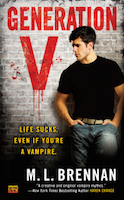 the character?
the character?
Suzume was a fan favorite from day one, and the most common question that I get asked is whether she'll be getting a spin-off series. She's also one of my own personal favorites -- any scene that she's in is just automatically more fun to write.
In terms of why a kitsune -- once I knew that I wanted to work with vampires, I immediately knew that I really just had to pair that with a non-Western monster mythos. We're so used to seeing vampires and werewolves together that it's become a trope, and so I looked at shapeshifting myths from many cultures. That led me to the kitsune, and it was practically love at first sight.
I actually did a lot more research into kitsune myths than into vampires. I knew I wanted to make substantial changes to vampires, but because the kitsune come from a culture that I'm not a part of, I felt that it was important to approach that creature with a great deal of respect. I did a lot of research into kitsune, reading everything from children's fairytales to a graduate thesis on the significance of kitsune to Japanese culture. Kitsune are actually found in several Asian cultural myths, but I ended up drawing all of my elements from Japanese sources, because I liked that particular take on them. While Korean kitsune, for example, are almost entirely malicious, Japanese kitsune have much more variety. In some stories they can be malicious, but in others they can respond positively to courtesy. There are stories where a character can be saved because of the positive actions of a kitsune. I liked the freedom that this brought me as a writer -- it allowed me to keep that connection to the traditional myths of kitsune while at the same time fitting them into the world that I was constructing.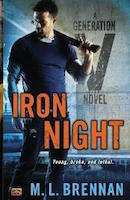
Parts of this story are about Fort coming of age. The struggle to cling to his humanity, and Fort fighting to come to terms with what survival means -- and that he does want to survive -- went far beyond any coming-of-age story I've read to date. How important was that to you?
Absolutely fundamental. I've always liked engaging with the idea of survival -- survival at any cost, or is there a line that shouldn't be crossed, and also the personal desire for life -- and some of the best parts of this series for me to write have always been when Fort is encountering these elements head-on. Fort wants to live and thrive -- yet at the same time he has an absolute horror for the way the rest of his family functions, and this leads to a great deal of fear of self, because he's aware that many of the decisions he might have to make out of necessity could lead him to become exactly like the thing he is most solidly aligned against.
Fort's coming of age actually bears the most similarity to Michael Corleone in The Godfather. Here's a character who is an idealist and a populist, but at the same time he's in a situation where morals and notions of justice start running up against real-world situations of realpolitik and expediency. At the core of this character is that old classic of a young adult to the ruling generation -- "I'll never be like you." Well, we saw what happened to the generation of hippies and flower children -- they ended up on Wall Street and in all the positions of power, and became exactly what they'd once rejected. For me, writing these books has always been about a character who wants nothing to do with his family, and rejects everything about them, but finds both biology and circumstance forcing him closer and closer to those things -- and still fights it. It's the heart of the whole series.
What was the hardest part of writing these books for you? What was the hardest scene?
When I wrote the first book, my plan was to have Fort and Suzume become friends over the course of the first book, and then have a platonic relationship for the remainder of the series. I wrote that first book with that very much in mind -- and that's what happens. But what startled me was how much everyone (literally everyone) who read that first book was immediately asking me when Fort and Suzume were going to get together -- not just out of proximity, but because they were legitimately invested in tha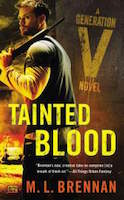 t pairing. And when I looked through the manuscript again, I realized that while I'd written this book with those ideals, it actually did make a lot of sense. The characters were strong in ways that the other was weak in, and vice versa, so every scene between them was always pushing and driving the other into new directions and growth. It made a great friendship, but when I thought about it, it also would make for a pretty amazing relationship for the series.
t pairing. And when I looked through the manuscript again, I realized that while I'd written this book with those ideals, it actually did make a lot of sense. The characters were strong in ways that the other was weak in, and vice versa, so every scene between them was always pushing and driving the other into new directions and growth. It made a great friendship, but when I thought about it, it also would make for a pretty amazing relationship for the series.
I ultimately decided to go in that direction, but something that I was very worried about was the relationship "taming" either of the characters. These were two very different characters -- Fort is an idealist and has this wonderful deep well of empathy, whereas Suzume has a playfulness that overlays this absolute steely ability to compartmentalize and protect her own, regardless of the cost to anyone else. Both of them had a place in the world that I'd made, and neither worldview was wrong. I made it a really set-in-stone priority that neither was going to decide to "change" or "fix" the other. If they were going to go in the relationship direction, than I needed it to be about a mutual respect and a bedrock of friendship -- that was the only way that it would work for me as a writer.
That was very challenging -- I spent a lot of time when I was writing really thinking about whether I was hitting that balance effectively, and working and rewriting to keep that functional. And it got even harder once the characters actually took the step at the end of the third book and became romantically involved -- the fourth book was a very intense writing experience, definitely the hardest of the series so far, because the romantic element did make that more complicated, and the characters really had to overtly grapple more with actively working to maintain that respect. 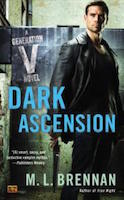 There's a scene in the fourth book where the two are having an argument, and I rewrote that one more times than I've rewritten any one scene in the rest of the series. I was extremely happy with the outcome, but it definitely came about only with a lot of sweat and elbow-grease.
There's a scene in the fourth book where the two are having an argument, and I rewrote that one more times than I've rewritten any one scene in the rest of the series. I was extremely happy with the outcome, but it definitely came about only with a lot of sweat and elbow-grease.
What are you working on now?
A: The fourth book in the Generation V series, Dark Ascension, comes out on August 4th of this year, so that's been extremely exciting! Right now I'm taking a small break from the world of Fortitude Scott and working on a new manuscript -- I can't reveal too many details yet, but I can say that all the fans of the kitsune have something to look forward to.
For M. L. Brennan's thoughts on writing, publishing, and the world in general, please check out her web site. To see a seemingly-infinite variety of profanity-laced humor, check her out on Twitter at @BrennanML.
David Busboom's story "Monsters on the Campus" appears in the August issue of GonzoToday.
Anna Kashina has really great news -- her novel The Guild of Assassins won two Prism Awards, topping the fantasy category.
Tim Major's short story "For a Tooth" appeared in Every Day Fiction and his story "Tunnel Vision" is part of the Kitchen Sink Gothic anthology from Parallel Universe Publications.
Fran Wilde has some exciting news she wants to share. Her high-fantasy novella The Jewel and Her Lapidary is forthcoming from Tor.com Publishing. Look for it in spring or summer of 2016.
Come on, OWW members and alums! We know you are more prolific than this. Please take a minute to send news of your writing accomplishments to news (at) onlinewritingworkshop.com so we can help you promote your writing!
The Reviewer Honor Roll is a great way to pay back a reviewer for a really useful review. When you nominate a reviewer, we list the reviewer's name, the submission/author reviewed, and your explanation of what made the review so useful. The nomination appears in the Honor Roll area of OWW the month after you submit it, and is listed for a month. You can nominate reviewers of your own submissions or reviewers of other submissions, if you have learned from reading the review. Think of it as a structured, public "thank you" that gives credit where credit is due and helps direct other OWWers to useful reviewers and useful review skills.
Visit the Reviewer Honor Roll page for a complete list of nominees and explanatory nominations.
July 2015 Honor Roll Nominees
Reviewer: Rachael Garza
Submission: The Ashia Legend by Peter Alex
Submitted by: Peter Alex
Reviewer: Melissa Chai
Submission: Truly Reverse 0 saga chapter 2 by josh head
Submitted by: josh head
Reviewer: Allan Dyen-Shapiro
Submission: "nox" (reworked) and noxx (taken down) by Tim Hawken
Submitted by: Tim Hawken
Reviewer: Owen Richards
Submission: "Soul Collector" by Theresa Gillmore
Submitted by: Theresa Gillmore
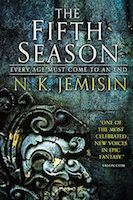 The Fifth Season (The Broken Earth) by N. K. Jemisin (Orbit, August 2015)
The Fifth Season (The Broken Earth) by N. K. Jemisin (Orbit, August 2015)
THIS IS THE WAY THE WORLD ENDS. FOR THE LAST TIME.
A season of endings has begun. It starts with the great red rift across the heart of the world's sole continent, spewing ash that blots out the sun. It starts with death, with a murdered son and a missing daughter. It starts with betrayal, and long dormant wounds rising up to fester.
This is the Stillness, a land long familiar with catastrophe, where the power of the earth is wielded as a weapon. And where there is no mercy.
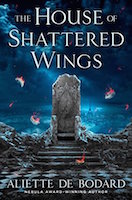 The House of Shattered Wings by Alliette de Bodard (Roc, August 2015)
The House of Shattered Wings by Alliette de Bodard (Roc, August 2015)
In the late twentieth century, the streets of Paris are lined with haunted ruins, the aftermath of a Great War between arcane powers. The Grand Magasins have been reduced to piles of debris, Notre-Dame is a burnt-out shell, and the Seine has turned black with ashes and rubble and the remnants of the spells that tore the city apart. But those that survived still retain their irrepressible appetite for novelty and distraction, and The Great Houses still vie for dominion over France's once grand capital.
Once the most powerful and formidable, House Silverspires now lies in disarray. Its magic is ailing; its founder, Morningstar, has been missing for decades; and now something from the shadows stalks its people inside their very own walls.
Within the House, three very different people must come together: a naive but powerful Fallen angel; an alchemist with a self-destructive addiction; and a resentful young man wielding spells of unknown origin. They may be Silverspires' salvation -- or the architects of its last, irreversible fall. And if Silverspires falls, so may the city itself.
Fees: $49/year, $30/6 months, or $6/month. First trial month free. (more)
How to pay: PayPal, Kagi, check in US dollars, money order in US dollars, barter (more)
Scholarship fund: We accept scholarship fund donations and award full or partial scholarships to active members in need. (more)
Gift memberships: You can give a gift membership for another member; just send us a payment by whatever method you like, noting who the membership is for and specifying whether the gift is anonymous or not. We will acknowledge receipt to you and the member.
Bonus payments: The workshop costs only 94 cents per week, but we know that many members feel that it's worth much more to them. 25% of any bonus payments we receive will go to our support staff; the rest will be tucked away to lengthen the shoestring that is our budget and keep us running! (more)
This month's featured article from our Tips and Advice section:
Since so many of the EC reviews this month focused on close reading an analysis of scenes and sentences and what they were doing or not doing for the submissions, we thought you might want to have a look at workshop alum Carlos Cortes's advice on pacing and making every scene count.
Got a helpful tip for your fellow members? A trick or hint for submitting or reviewing, for what to put in your author's comments, for getting good reviews, or for formatting or titling your submission? Share it with us and we'll publish it in the next newsletter. Just send it to support (at) sff.onlinewritingworkshop.com and we'll do the rest.
The Online Writing Workshop for Science Fiction, Fantasy & Horror
sff.onlinewritingworkshop.com
support (at) sff.onlinewritingworkshop.com